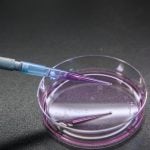One day, non-therapeutic antibiotics may be banned from the hog industry.
But while that prospect may cause worries about diseased meat being produced by untreated pigs, a British researcher said such a change doesn’t have to be the end of the world.
Peter Brooks of the University of Plymouth in England said many of today’s widespread bacterial disease problems in barns are the result of pelleted feed. The solution could come from adopting a radically new feed approach.
“Liquid feed can be the answer to some vexing health concerns,” said Brooks.
Read Also

Breaking down successful winter feeding into six steps
It’s that time of year when it is important to start planning for a cow herd’s winter feeding program. Here are six steps I think are necessary to consider when getting your feed tested.
“You may not be using liquid feed yet, but if you can’t use antibiotics in the future, you may want to consider it.”
Many diseases dangerous to humans, such as salmonella and coliform bacteria, exist in pig herds and often end up on carcasses in abattoirs. Some infected meat reaches the supermarkets and some consumers who don’t adequately cook the meat get sick.
That’s one reason why the hog industry has been keen to use antibiotics on all pigs regardless of whether they are infected. The industry wants to minimize the incidence of potentially dangerous diseases so that fewer people get ill.
Europe has already curtailed the use of antibiotics for pigs that aren’t sick and further regulations will make non-therapeutic use of antibiotics rare.
Brooks said the same restrictions on antibiotics will eventually occur in North America, so producers should prepare themselves.
He said switching to a fermented liquid feed diet from a pelleted dry matter diet can virtually eliminate the pathogens in pig feed and would work well in an antibiotic-free environment.
Feed companies convinced producers to switch to pelleted feed because that form was believed to be best for pig digestion, but Brooks said pelleting increases the rates of salmonella and other bacterial infections in pigs.
That’s because pelleted food passes quickly through the pig’s stomach and the natural lactic acid doesn’t have time to kill off the bacteria. Lactic acid kills almost all dangerous bacterial pathogens if left to act for long enough.
Ground dry matter feeds produce much lower levels of salmonella and coliform bacteria in pigs’ guts, Brooks said, and fermented liquid feed almost eliminates them.
One European study found an 8.2 percent infection rate in barns feeding pelleted feed, 4.2 percent for barns feeding non-pelleted dry feed, and only one percent for those feeding liquid feed.
Ground pig feed stays in pigs’ stomachs longer than pellets do, so the lactic acid can build up and kill most of the pathogens before they pass into the lower gut.
Fermented liquid feed is already rich with lactic acid, so few pathogens have a chance of surviving, Brooks said. Not only does the lactic acid kill most of the pathogens before it ever gets to the pig, but it also passes on the acid to the pig’s stomach.
A Dutch study of 320 sow barns found pigs given dry feed were 10 times more likely to have salmonella than those in a barn using liquid feeds.
Brooks said research has shown that on-farm mixes can vary wildly in their lactic acid levels and often don’t have enough acid to work. Commercially produced liquid feeds with tightly controlled lactic acid levels and times of exposure are a good solution, but are illegal in the European Union because they need special registration, a situation Brooks called absurd.
Sows fed fermented liquid feed with good lactic acid levels appear to pass on some of the benefit to their piglets through their colostrum.
The piglets also benefit from the much lower incidence of salmonella and other diseases in the sow’s feces, Brooks said.
In nature, a sow never defecates near its piglets, but this is unavoidable in many barn situations. That’s why it is important to keep the disease count low in the mother’s feces in the barn because the piglets are in a vulnerable position.
Brooks said lactic acid is a powerful killer of most bacterial infections, but it is not able to kill most yeasts and moulds, so producers using fermented liquid feeds still need to watch out for those problems.















